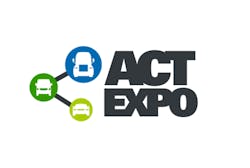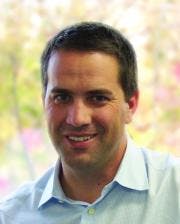ACT Expo preview: Customers, not regs, drive 'miraculous' truck tech
Talk of a Trump administration rollback of federal heavy-duty vehicle fuel economy standards, or the Phase 2 greenhouse gas emissions reduction plan (GHG 2), is essentially meaningless, suggests an expert in fuel efficiency programs. Truck buyers clearly want more efficient trucks and, even if EPA backs off the GHG 2 mandate, California is ready and willing to roll out even more stringent requirements of its own.
“From the customer’s perspective, there’s a path to get to 10 mpg. If the current administration backs off of Phase 2, maybe that’s fine—because trucking is not typically a big fan of regulation,” says Eric Neandross, CEO at Gladstein, Neandross, and Associates, a consulting firm specializing in clean transportation and organizer of the upcoming Advanced Clean Transportation (ACT) Expo. “But if there’s no regulation, does that mean I’m going to stop asking my truck manufacturer to provide more efficient trucks, which they’ve just said they can do? Customers are going to want 10 mpg, Phase 2 or no Phase 2.”
And while the industry has voiced concerns over the capital costs of the new trucks and new technologies of GHG 2, the “long term, big picture” is that fuel cost savings should be significant. The essential difference would be that, without the government’s deadlines, market-driven development could come more slowly.
Indeed, the industry has been focused on the path to 10 mpg and beyond since clearing the significant hurdles imposed by the EPA emissions regs in 2007 and 2010. Neandross cites truck platooning and evolving autonomous truck technology as leading examples of market-driven solutions—ironically, developments that are potentially hampered by the lack of a forward-looking regulatory structure.
But California, through the state’s Air Resources Board (CARB) has no qualms about regulating the future starting today, EPA rules or no. The California Sustainable Freight Action Plan aims to improve freight efficiency and deploy 100,000 vehicles capable of zero-emission operation by 2030.
“CARB will continue to push full steam ahead,” Neandross says. “The intent seems to be to meet any sort of backsliding at the federal level with even more aggressive activity—digging in, if you will. California sees its activities as even more important if there’s not that consistency at the federal level.”
Though some in transportation have suggested that if EPA relaxed the clean air standards that routinely put areas in Southern California into “non-attainment” status, CARB would have no incentive to push ahead.
Indeed, the “strategy” for light-duty vehicle emissions (with heavy-duty to follow suit) shapes up like this, according to Neandross: EPA relaxes clean air standards, then California sets its own. Manufacturers then argue against having two sets of standards. In turn, the federal government takes away the California exemption under the Clean Air Act.
But Neandross points out the state has already hired former U.S. Attorney General Eric Holder to protect in court California’s right to set its clean air rules. “They’re ready for battle,” Neandross says.
For trucking, a CARB plan to implement more strict NOx limits is in development and would require such a waiver from the EPA. Additionally, the state is also looking to further reduce the carbon density in transportation fuel, going from the current 10% reduction to a 20-30% reduction.
A zero-emission vehicle? No such thing
As for the Freight Action Plan, “the great debate” currently underway is over what, exactly, constitutes a zero-emission vehicle, Neandross explains. And how that question is answered will determine the future for natural gas- and diesel-powered trucks in California.
“There really is no such thing as zero emissions,” he says. “It’s a question of ‘displaced’ emissions. Are the emissions at the power plant or at the tailpipe?”
The issue has emerged from the California rule regarding the transition to zero-emission transit vehicles. This phase-in requires transit agencies to buy battery-electric and hydrogen fuel cell buses. But the natural-gas vehicle industry—which has “pretty much owned that market” as the dominant alternative to diesel—now has a near-zero natural gas engine to go along with growing supplies of renewable natural gas fuel.
This adds up to a vehicle that can nearly match the environmental benefit of an electric bus plugged into the grid, Neandross explains, and it can be done for 1/3 the price—and the technology and infrastructure are available today.
“On paper, when you look at the analysis, the natural gas guys say why wait until 2030, why not just use natural gas?” Neandross continues. “But CARB says, ‘we want zero tailpipe emissions.’ The same logic and the same arguments will apply to last-mile [vehicles]. We’re starting to see some of this debate in the new port program for LA/Long Beach.”
“It’s an interesting time. I think we’re starting to see some interesting things in the plug-in hybrid world,” Neandross said. “And we’re starting to see some initial deployment of electric trucks, but they’re so heavily subsidized that it’s hard to say they’re truly commercial and economically viable.”
He also calls hydrogen fuel cells for trucks “very intriguing,” but questions the timetable for developing the necessary infrastructure.
Then again, “if you can do it with a 9-liter natural gas engine that has basically no emissions and almost no GHG emissions, that’s pretty compelling,” Neandross says.
The problem is CARB overlooks effective technologies that are available now and for the near future because of its “many long-term expectations” based around renewable energy powering the electrical grid.
“It’s a very rose-colored vision of the future,” Neandross says. “The challenge is that we’re missing many opportunities to do good things today, which includes cleaning the air up. What’s our goal? Is it to clean up the air and reduce the amount of GHG that goes in the atmosphere? Yes. Can we do that today with low-NOx renewable fuel?Yes. So why are we hearing from folks who present themselves as environmentalists not to do that? It’s sort of perplexing.”
Can diesel survive?
So what about the potential for low NOx diesels—which, according to Neandross, is where CARB wants trucking to go?
In talking to diesel engine manufacturers, Neandross has heard doubts about the attainability of the expected CARB targets, and whether those very low targets are truly necessary—or even accurately measurable. But natural gas engine makers are more optimistic.
“It puts a lot of pressure on the diesel guys, in terms of market competitiveness,” he says.
Regardless, trucking needs to get credit for the improvements made in freight efficiency and engine emissions, and the potential to move forward with existing and viable new technologies.
“It’s really miraculous when you think about an 80,000-lb. Class 8 heavy-duty truck driving down the road, hauling freight, having the same tailpipe emissions as a Ford Taurus or something,” he says. “That truly is a feat of engineering to get emissions that low from something doing that much work in society.”
To that end, ACT 2017 will focus on these more traditional technologies and the very bright outlook for fleets who take advantage of them. The trucking-track highlights include an opening panel, moderated by Fleet Owner Editor Jim Mele, to discuss “The Future of Heavy-Duty Trucking” and the still critical role of advanced clean diesel technology.
A subsequent session will focus on freight efficiency, diving deeper into the EPA's Phase 2 GHG Rule to help fleet customers understand what this regulation will really mean to their future planning and procurement plans. Beyond GHG 2, attendees will get an update on the second round of SuperTruck projects aimed at developing and demonstrating technologies to improve heavy-truck freight efficiency by more than 100%, relative to a manufacturer’s best-in-class 2009 truck. Attendees also will hear which OEMs are participating, what technologies they will be testing, and what goals they hope to achieve.
“There’s a lot out there—and that doesn’t even get into natural gas, electric, propane, fuel cells, or any of the other stuff,” Neandross says. “What we’ve really done for ACT this year is focus on the traditional, and put the alternatives around that. In the past, the alternatives have been center stage, the main attraction, but we’ve shifted that this year.”
More program and registration details are here.
About the Author
Kevin Jones 1
Editor
Kevin has served as editor-in-chief of Trailer/Body Builders magazine since 2017—just the third editor in the magazine’s 60 years. He is also editorial director for Endeavor Business Media’s Commercial Vehicle group, which includes FleetOwner, Bulk Transporter, Refrigerated Transporter, American Trucker, and Fleet Maintenance magazines and websites.


